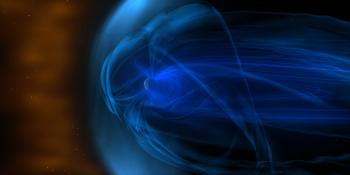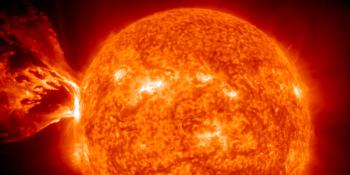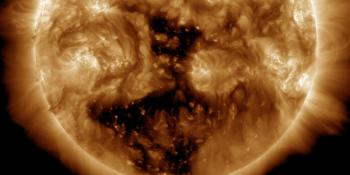Viewing archive of Monday, 20 May 2024
Daily bulletin on solar and geomagnetic activity from the SIDC
Issued: 2024 May 20 1231 UTC
SIDC Forecast
Solar flares
M-class flares expected (probability >=50%)
Geomagnetism
Quiet (A<20 and K<4)
Solar protons
Warning condition (activity levels expected to increase, but no numeric forecast given)
| 10cm flux | Ap | |
|---|---|---|
| 20 May 2024 | 201 | 007 |
| 21 May 2024 | 201 | 013 |
| 22 May 2024 | 201 | 022 |
Solar Active Regions and flaring
There are nine visible ARs on the solar disk. Flaring activity was driven by NOAA AR 3685 (beta-gamma magnetic field configuration) with three M-class flares, the strongest being an M2.5 one peaking at 17:47 UTC on 21 May. NOAA AR 3683 (beta magnetic field configuration) has produced several C-class flares today and has potential for stronger ones. More M-class flares are likely and X-class flares are possible in the next 24 hours.
Coronal mass ejections
A full halo CME was first seen at 05:36 UT on LASCO C2, originating from an eruption close to NOAA AR 3683 (located at the southwest, at S25W60), associated with a C6.7 flare. The CME speed is around 1500 km/s.The bulk of the CME is directed to the southwest, but a glancing blow can be expected on 22 May.
Solar wind
The solar wind at the Earth is slow, with speeds around 350 km/s and interplanetary magnetic field around 8 nT. There are low chances of a glancing blow from the CME on 17 May, otherwise slow wind conditions can be expected for the next 24 hours.
Geomagnetism
Geomagnetic conditions have been quiet in the last 24 hours (Kp and K_BEL up to 2). If we see a glancing blow from the 17 May CME, disturbed conditions may occur, otherwise quiet conditions can be expected for the next 24 hours.
Proton flux levels
The 10 MeV GOES-18 proton flux was below threshold in the past 24 hours. It may increase over the next hours as a result of the halo CME from 05:36 UTC.
Electron fluxes at geostationary orbit
The greater than 2 MeV electron flux from GOES 16 was below the threshold level in the last 24 hours. It is expected to remain below the threshold during the next 24 hours. The electron fluence was at normal levels for the last 24 hours and is expected to remain so.
Today's estimated international sunspot number (ISN): 146, based on 22 stations.
Solar indices for 19 May 2024
| Wolf number Catania | /// |
| 10cm solar flux | 201 |
| AK Chambon La Forêt | 015 |
| AK Wingst | 012 |
| Estimated Ap | 011 |
| Estimated international sunspot number | 167 - Based on 25 stations |
Noticeable events summary
| Day | Begin | Max | End | Loc | Strength | OP | 10cm | Catania/NOAA | Radio burst types |
|---|---|---|---|---|---|---|---|---|---|
| 19 | 1337 | 1344 | 1348 | S10E36 | M1.9 | 1N | 10/3685 | III/3 | |
| 19 | 1747 | 1756 | 1800 | S10E34 | M2.5 | 1B | 10/3685 | III/3 | |
| 19 | 2153 | 2159 | 2203 | S09E34 | M1.6 | 1N | 10/3685 | III/2 |
Provided by the Solar Influences Data analysis Center© - SIDC - Processed by SpaceWeatherLive
All times in UTC
Latest news
Latest forum messages
Support SpaceWeatherLive.com!
A lot of people come to SpaceWeatherLive to follow the Sun's activity or if there is aurora to be seen, but with more traffic comes higher server costs. Consider a donation if you enjoy SpaceWeatherLive so we can keep the website online!

Space weather facts
| Last X-flare | 2025/03/28 | X1.1 |
| Last M-flare | 2025/04/22 | M1.3 |
| Last geomagnetic storm | 2025/04/21 | Kp5+ (G1) |
| Spotless days | |
|---|---|
| Last spotless day | 2022/06/08 |
| Monthly mean Sunspot Number | |
|---|---|
| March 2025 | 134.2 -20.4 |
| April 2025 | 121.5 -12.7 |
| Last 30 days | 116.5 -16.8 |


